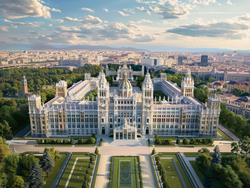Palace of Montemolino: Difference between revisions
(Created page with "{{Nouvelle Alexandrie Article}} {{Infobox building | name = Palace of Montemolino | native_building_name = | native_name_lang = | image = | image_size = | caption = | location = Cárdenas | location_country = {{team flag|Nouvelle Alexandrie}} | building_type = Royal and public complex | architectural_style = Neo-Alexandrian | construction_start_date = {{AN|1710}} | c...") |
No edit summary |
||
| (One intermediate revision by the same user not shown) | |||
| Line 4: | Line 4: | ||
| native_building_name = | | native_building_name = | ||
| native_name_lang = | | native_name_lang = | ||
| image = | | image = [[File:PalaceofMontemolino1730.png|250px]] | ||
| image_size = | | image_size = | ||
| caption = | | caption = | ||
| Line 21: | Line 21: | ||
The '''Palace of Montemolino''' ([[Martino language|Martino]]: ''Palacio de Montemolino'') is an expansive palatial complex covering 200 hectares in the heart of [[Cárdenas]], [[Nouvelle Alexandrie]]. Constructed between {{AN|1710}} and {{AN|1718}} under the guidance of the renowned architect Javier Montemayor, the palace features a grand Neo-[[Alexandria|Alexandrian]] Revival style, combining opulent design with practical functionality. While it serves as a residence for numerous members of the extended royal family, the complex is primarily a public institution, incorporating museums, offices, archives, and spaces for cultural and civic engagement. | The '''Palace of Montemolino''' ([[Martino language|Martino]]: ''Palacio de Montemolino'') is an expansive palatial complex covering 200 hectares in the heart of [[Cárdenas]], [[Nouvelle Alexandrie]]. Constructed between {{AN|1710}} and {{AN|1718}} under the guidance of the renowned architect Javier Montemayor, the palace features a grand Neo-[[Alexandria|Alexandrian]] Revival style, combining opulent design with practical functionality. While it serves as a residence for numerous members of the extended royal family, the complex is primarily a public institution, incorporating museums, offices, archives, and spaces for cultural and civic engagement. | ||
The palace is home to the [[Royal Archives of Nouvelle Alexandrie]], a significant repository of historical documents and artifacts that illustrate the nation's cultural and political evolution. It also houses offices for the [[Royal Household]] and various non-profit organizations championed by the [[King of Nouvelle Alexandrie]]. Large sections of the complex are open to the public, including museums that display art, historical exhibitions, and the contributions of the monarchy to national development. Spanning its vast grounds, the Palace of Montemolino includes meticulously landscaped gardens, public parks, and walking trails, making it a cherished cultural and recreational hub for the citizens of [[Cárdenas]] and visitors alike. | The palace is home to the [[Royal Archives of Nouvelle Alexandrie]], a significant repository of historical documents and artifacts that illustrate the nation's cultural and political evolution. It also houses offices for the [[Royal Household of Nouvelle Alexandrie]] and various non-profit organizations championed by the [[King of Nouvelle Alexandrie]]. Large sections of the complex are open to the public, including museums that display art, historical exhibitions, and the contributions of the monarchy to national development. Spanning its vast grounds, the Palace of Montemolino includes meticulously landscaped gardens, public parks, and walking trails, making it a cherished cultural and recreational hub for the citizens of [[Cárdenas]] and visitors alike. | ||
==See also== | ==See also== | ||
| Line 27: | Line 27: | ||
*[[Royal Archives of Nouvelle Alexandrie]] | *[[Royal Archives of Nouvelle Alexandrie]] | ||
*[[Royal Residences of Nouvelle Alexandrie]] | *[[Royal Residences of Nouvelle Alexandrie]] | ||
*[[Royal Household of Nouvelle Alexandrie]] | |||
*[[Palace of Carranza]] | *[[Palace of Carranza]] | ||
*[[Palace of Chinchero]] | *[[Palace of Chinchero]] | ||
| Line 39: | Line 40: | ||
[[Category:King of Nouvelle Alexandrie]] | [[Category:King of Nouvelle Alexandrie]] | ||
[[Category:Cárdenas]] | [[Category:Cárdenas]] | ||
[[Category:Palaces and mansions]] | |||
Latest revision as of 17:36, 6 December 2024
| Palace of Montemolino | |
 | |
| General information | |
|---|---|
| Type | Royal and public complex |
| Architectural style | Neo-Alexandrian |
| Location | Cárdenas |
| Country |
|
| Construction started | 1710 AN |
| Completed | 1718 AN |
| Owner | Monarchy of Nouvelle Alexandrie |
| Technical details | |
| Material | Stone and marble |
| Floor count | 4 |
| Grounds | 200 hectares |
| Design and construction | |
| Architect | Javier Montemayor |
The Palace of Montemolino (Martino: Palacio de Montemolino) is an expansive palatial complex covering 200 hectares in the heart of Cárdenas, Nouvelle Alexandrie. Constructed between 1710 AN and 1718 AN under the guidance of the renowned architect Javier Montemayor, the palace features a grand Neo-Alexandrian Revival style, combining opulent design with practical functionality. While it serves as a residence for numerous members of the extended royal family, the complex is primarily a public institution, incorporating museums, offices, archives, and spaces for cultural and civic engagement.
The palace is home to the Royal Archives of Nouvelle Alexandrie, a significant repository of historical documents and artifacts that illustrate the nation's cultural and political evolution. It also houses offices for the Royal Household of Nouvelle Alexandrie and various non-profit organizations championed by the King of Nouvelle Alexandrie. Large sections of the complex are open to the public, including museums that display art, historical exhibitions, and the contributions of the monarchy to national development. Spanning its vast grounds, the Palace of Montemolino includes meticulously landscaped gardens, public parks, and walking trails, making it a cherished cultural and recreational hub for the citizens of Cárdenas and visitors alike.